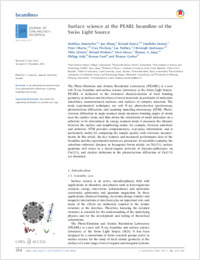Surface science at the PEARL beamline of the Swiss Light Source
- Muntwiler, Matthias Paul Scherrer Institut, Villigen, Switzerland
- Zhang, Jun Paul Scherrer Institut, Villigen, Switzerland
- Stania, Roland Paul Scherrer Institut, Villigen, Switzerland - Universität Zürich, Switzerland
- Matsui, Fumihiko Nara Institute of Science and Technology (NAIST), Nara, Japan
- Oberta, Peter Paul Scherrer Institut, Villigen, Switzerland
- Flechsig, Uwe Paul Scherrer Institut, Villigen, Switzerland
- Patthey, Luc Paul Scherrer Institut, Villigen, Switzerland
- Quitmann, Christoph Paul Scherrer Institut, Villigen, Switzerland - MAX IV Laboratory, Lund University, Sweden
- Glatzel, Thilo Universität Basel, Switzerland
- Widmer, Roland Swiss Federal Laboratories for Materials Science and Technology (Empa), Dübendorf, Switzerland
- Meyer, Ernst Universität Basel, Switzerland
- Jung, Thomas A. Paul Scherrer Institut, Villigen, Switzerland - Universität Basel, Switzerland
- Aebi, Philipp Université de Fribourg, Switzerland
- Fasel, Roman Swiss Federal Laboratories for Materials Science and Technology (Empa), Dübendorf, Switzerland
- Greber, Thomas Universität Zürich, Switzerland
-
01.01.2017
Published in:
- Journal of Synchrotron Radiation. - 2017, vol. 24, no. 1, p. 354–366
English
The Photo-Emission and Atomic Resolution Laboratory (PEARL) is a new soft X-ray beamline and surface science laboratory at the Swiss Light Source. PEARL is dedicated to the structural characterization of local bonding geometry at surfaces and interfaces of novel materials, in particular of molecular adsorbates, nanostructured surfaces, and surfaces of complex materials. The main experimental techniques are soft X-ray photoelectron spectroscopy, photoelectron diffraction, and scanning tunneling microscopy (STM). Photoelectron diffraction in angle-scanned mode measures bonding angles of atoms near the emitter atom, and thus allows the orientation of small molecules on a substrate to be determined. In energy scanned mode it measures the distance between the emitter and neighboring atoms; for example, between adsorbate and substrate. STM provides complementary, real-space information, and is particularly useful for comparing the sample quality with reference measurements. In this article, the key features and measured performance data of the beamline and the experimental station are presented. As scientific examples, the adsorbate-substrate distance in hexagonal boron nitride on Ni(111), surface quantum well states in a metal-organic network of dicyano-anthracene on Cu(111), and circular dichroism in the photoelectron diffraction of Cu(111) are discussed.
- Faculty
- Faculté des sciences et de médecine
- Department
- Département de Physique
- Language
-
- English
- Classification
- Physics
- License
-
License undefined
- Identifiers
-
- RERO DOC 287938
- DOI 10.1107/S1600577516018646
- Persistent URL
- https://folia.unifr.ch/unifr/documents/305362
Other files
Statistics
Document views: 107
File downloads:
- pdf: 194
- Supplementary material: 171

